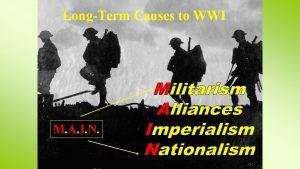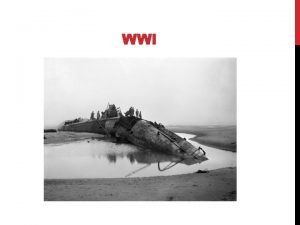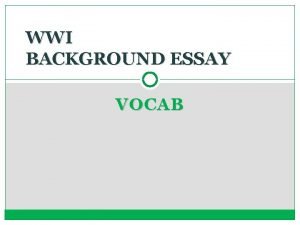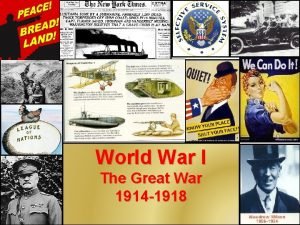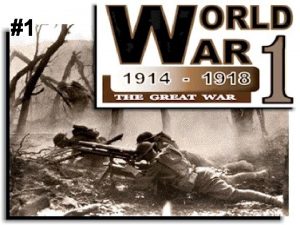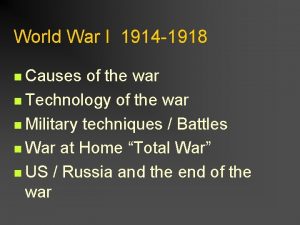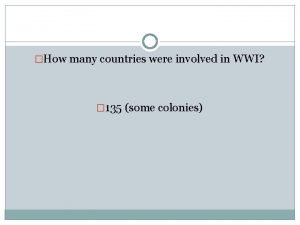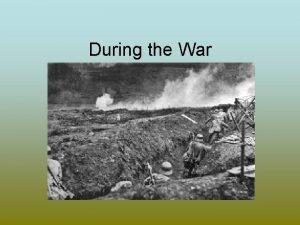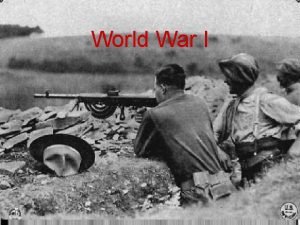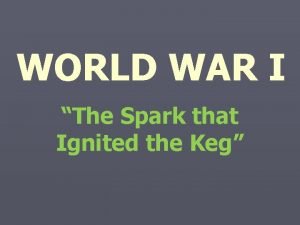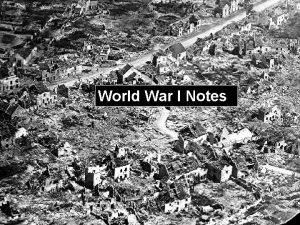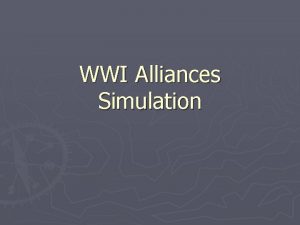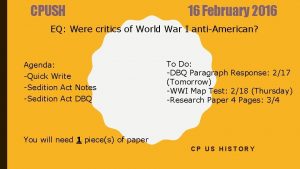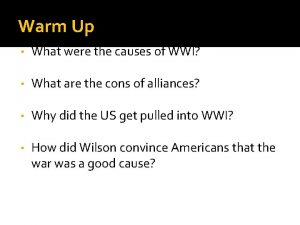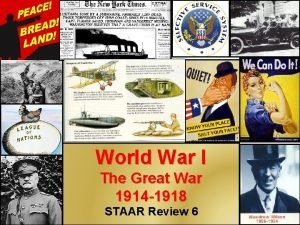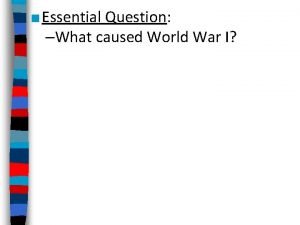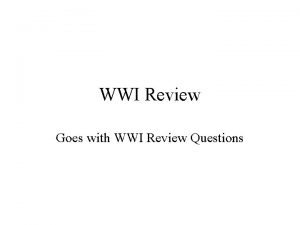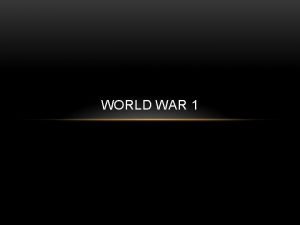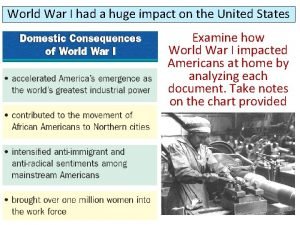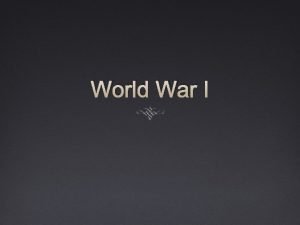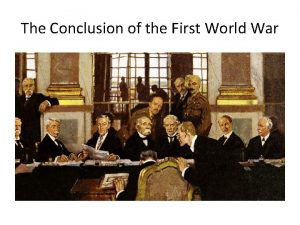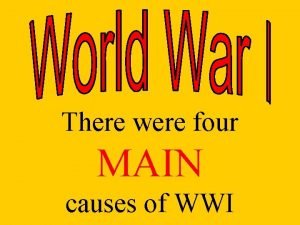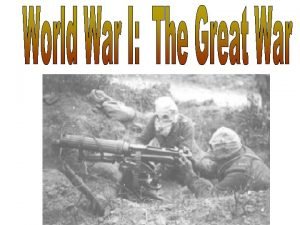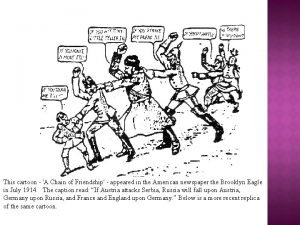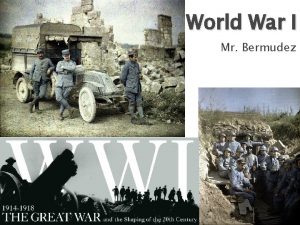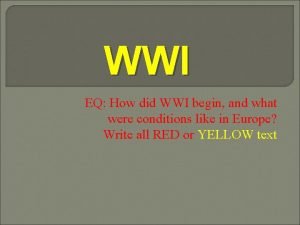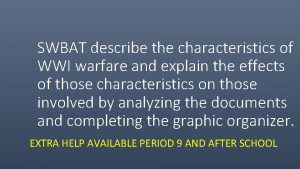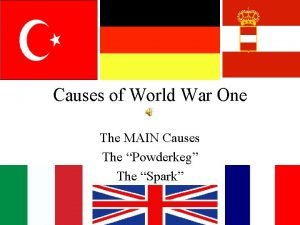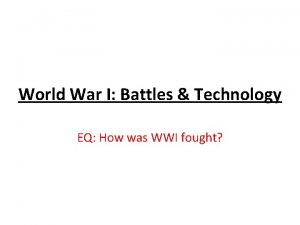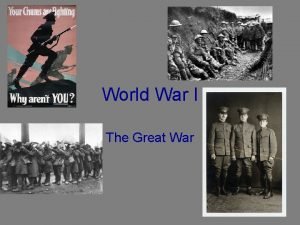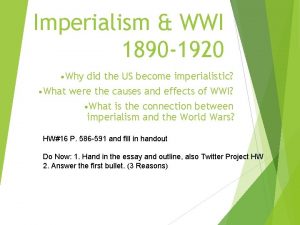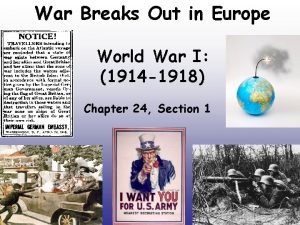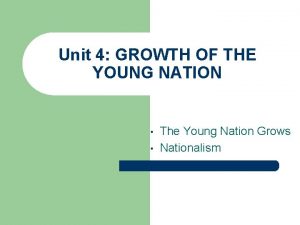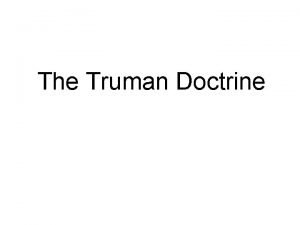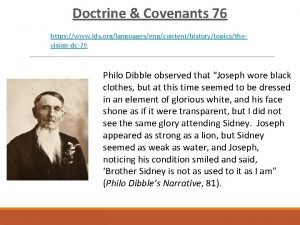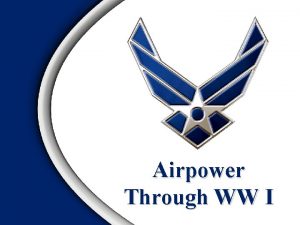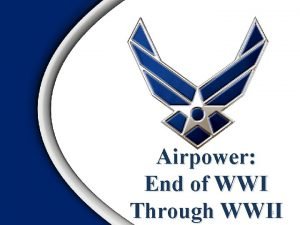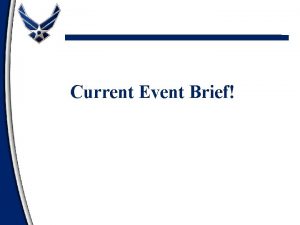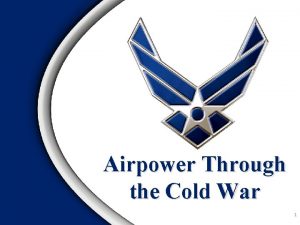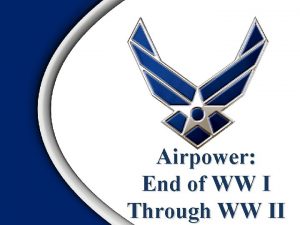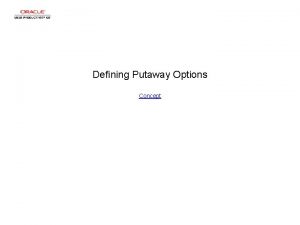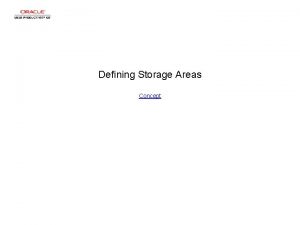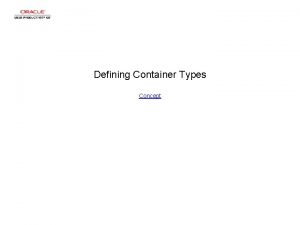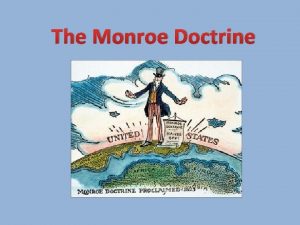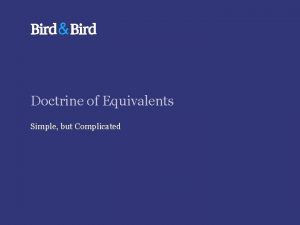Airpower Through WWI Overview Defining Airpower Airmindedness Doctrine






















































- Slides: 54

Airpower Through WWI

Overview • • Defining Airpower Airmindedness Doctrine Principles of War Tenets of Airpower Application of Airpower Lighter-than-air Vehicles Heavier-than-air Vehicles 2

Overview • • Early Uses of Airpower in WWI The Battle for Air Supremacy US Participation in WWI Close Air Support and Interdiction in WWI Development of Tactics in WWI Strategic Bombing Theorists Evolution of Airpower 3

What is Airpower? “Airpower is the ability to project military power or influence through the control and exploitation of air, space, and cyberspace to achieve strategic, operational, or tactical objectives. ” ~ 4

Airpower • Interdependent Dimensions • Air • Space • Cyberspace 5

Airmindedness • Unique Perspective of Airmen – Not merely abstract term to capture how Airmen feel; rather, it is an active cognitive process that leads to proper application of airpower – Enables Airmen to think/act at tactical, operational, and strategic levels of war 6

Doctrine • Definition: Fundamental principles by which the military forces or elements thereof guide their actions in support of national objectives. It is authoritative but requires judgment in application. ~ Joint Publication 1 -02 7

Doctrine • Air Force Doctrine – Describes and guides the proper use of airpower in military operations. – What we have come to understand, based on our experience to date – Prepares us for future uncertainties – Provides common set of understandings on which Airmen base their decisions. 8

Differentiating Policy, Strategy, and Doctrine • Policy: Guidance that is directive or instructive, stating what is to be accomplished. It reflects a conscious choice to pursue certain avenues and not others. • Strategy: Defines how operations should be conducted to accomplish national policy objectives. • Doctrine: Presents considerations on how to accomplish military goals and objectives. 9

Applying Doctrine • • War fighting, not physics Effects, not platforms Using mediums, not owning mediums Organization, not organizations Synergy, not segregation Integration, not just synchronization The right force, not just equal shares of the force 10

Principles of War “…those aspects of warfare that are universally true and relevant. ” ~ Joint Publication 1 11

Principles of War • Historically tested • Apply equally to all US Armed Forces • Unity of Command, Objective, Offense, Mass, Maneuver, Economy of Force, Security, Surprise, Simplicity 12

Principles of War • Unity of Command: All efforts should be directed and coordinated toward a common objective • Objective: Directing military operations toward a defined and attainable objective that contributes to strategic, operational, and tactical aims • Offensive: To act rather than react and to dictate time, place, purpose, scope, intensity, and pace of operations 13

Principles of War • Mass: The purpose of mass is to concentrate the effects of combat power at the most advantageous place and time to achieve decisive results • Maneuver: Places the enemy in a position of disadvantage through the flexible application of combat power in a multidimensional combat space 14

Principles of War • Economy of Force: Calls for the rational use of force by selecting the best mix of air, space, and cyberspace capabilities • Security: The purpose of security is to never permit the enemy to acquire unexpected advantage 15

Principles of War • Surprise: Leverages the security principle by attacking the enemy at a time, place, or in a manner for which they are not prepared • Simplicity: Calls for avoiding unnecessary complexity in organizing, preparing, planning, and conducting military operations 16

Principles of Operation • These, in combo with Principles of War, create Principles of Joint Ops • Unity of Effort • Perseverance • Legitimacy • Restraint 17

Tenets of Airpower • Fundamental truths that are unique to the air and space environment. – Centralized Control and Decentralized Execution – Flexibility/Versatility – Synergistic Effects – Persistence – Concentration – Priority – Balance 18

Tenets of Airpower • Centralized Control/Decentralized Execution – Airpower must be controlled by JFACC – Delegation of execution authority • Flexibility and Versatility – Flexibility allows airpower to quickly and decisively shift between campaign objectives – Versatility is using airpower effectively at all levels of warfare and with other joint force elements 19

Tenets of Airpower • Synergistic Effects – proper application of a coordinated force across multiple domains • Persistence – Conducting airpower operations continuously against a broad spectrum of targets • Concentration – Putting overwhelming power at the decisive time and place. 20

Tenets of Airpower • Priority – Limited resources require that airpower be applied where it can make the greatest contribution to the most critical requirements • Balance – Balancing principles of war and the tenets of airpower to bring Air Force capabilities together to produce a synergistic effect. 21

Application of Airpower • Differentiating Terms – Roles: Broad and enduring purposes for which the Services were established by law – Missions: Tasks assigned by the President or Secretary of Defense (Sec. Def) to combatant commanders – Functions: Specific responsibilities that enable the Services to fulfill their legally established roles 22

• Air Force Functions – – – – Nuclear Operations Air Superiority Counterair Counterland Space Operations Cyberspace Operations Command Control Global Integrated ISR Strategic Attack Air Mobility Personnel Recovery Combat Support Special Operations

Early Years of Flight • Man first flew aloft in a balloon in 1783 • Airpower did not have an immediate impact • Flying machines were not readily accepted by land oriented officers • Airpower’s first major impact was not until World War I 24

Balloons • Montgolfier Brothers flew first hotair balloon in 1783 • Ben Franklin saw first balloon flight and immediately he saw military potential • First used for military purposes by the French in 1794 at Maubege • Union and Confederate forces employed balloons during the American Civil War 25

Balloons • Adolphus W. Greely, the grandfather of military aviation in the United States; revived interest in military capability of balloons in 1891 – 1898: Greely balloon used to direct artillery fire during the Battle of San Juan Hill • Interest in balloons dropped quickly with the development of heavierthan-air vehicles 26

Dirigibles • Steerable balloons, often called “Airships” • 1884: first successful flight in a dirigible • Ferdinand Von Zeppelin—person most readily identified with dirigibles – Zeppelins first flown in 1900 – German dirigibles bombed England in WWI – German dirigibles flew surface fleet observation in WWI • Vulnerable to winds and ground fire 27

Uses of Balloons and Dirigibles • • • Reconnaissance Artillery spotting Bombing (extremely limited prior to WWI) Morale Booster/Escape Means Air transport of supplies 28

Early Pioneers of Flight • Otto Lilienthal—Studied gliders and first to explain the superiority of curved surfaces • Percy Pilcher—Built airplane chassis • Octave Chanute—Developed a double winged-glider/wrote history of flight to 1900 • Samuel P. Langley—First to secure government support to develop an airplane – Failed twice to fly from houseboat in 1903 – Congress withdrew monetary support 29

Orville & Wilbur Wright • First to fly a heavier-than-air, power-driven machine— 17 December 1903 – Flight traveled 120 feet and lasted 12 seconds • Approached flying scientifically and systematically • Used experience of Lilienthal, Pilcher, and Chanute • Built a glider in Dayton, Ohio in 1899 – Moved it to Kitty Hawk, N. Carolina in 1900 30

Wright Brothers Video 31

Reaction to the Airplane • US government was very skeptical at first – Not interested because of Langley’s failures • Britain and France were very enthusiastic • President Roosevelt directed the Secretary of War, W. H. Taft, to investigate the Wright Brothers’ invention in 1906 • Dec 1907—Chief Signal Officer, BG James Allen, issued Specification #486 calling for bids to build the first military aircraft 32

Signal Corp Spec. #486 • Established the requirements for the first military aircraft. Aircraft must be able to: – – – – Carry two persons Reach speed of 40 mph Carry sufficient fuel for 125 mile nonstop flight Be controllable in flight in any direction Fly at least 1 hour Land at take-off point, without damage Be taken apart and reassembled in 1 hour No military operational requirements specified 33

Signal Corp Spec. #486 • 41 proposals were received, only 3 complied with specifications • US Army signed contract with Wright Brothers on 10 February 1908 • Wright brothers delivered first military aircraft on 20 August 1908 • US Army accepted the first operational aircraft on 2 August 1909 34

Early Uses of Airpower • Until WWI balloons, dirigibles, and aircraft were primarily reconnaissance vehicles • Early on, the flying machines were not seen as weapons of war • Few believed the flying force was ready to be separate air force • The potential uses of aircraft would evolve considerably during WWI 35

World War I—Missions • Reconnaissance – Collecting visual and photographic information • Counterair – Air-to-air combat • Close Air Support – Support of ground forces • Interdiction – Striking enemy resources close to the battlefield • Strategic Bombing – Strikes deep into enemy territory to destroy war making capabilities 36

World War I—Missions • Reconnaissance and artillery spotting – Took away the element of surprise – Hampered by weather/unserviceable aircraft • Pursuit Aviation (Air superiority) – Grew out of attempts to deny reconnaissance – 1 st air-to-air kill occurred in October 1914 – Developed rapidly in WWI – Key to winning the air war 37

Technological Developments • Roland Garros (French): Developed metal strips for propellers so machine gun bullets would not shatter the props • Anthony Fokker (Dutch): Designed synchronizing gear so bullets would pass through the spinning propeller blades 38

Technological Developments • Nieuports and Spads (French): Most reliable and flexible aircraft in 1916 • Fokker Triplanes: German aircraft that put the Germans back on top in 1917 39

Rickenbacker Video 40

US Participation in WWI • When United States entered the war in April 1917, US Air Service was totally unprepared – Aviation Section had 56 pilots and less than 250 airplanes; none ready for combat • Congress approved $640 million in July 1917 to raise 354 combat squadrons • At the end of WWI, Air Service had 183, 000 personnel and 185 squadrons 41

Mitchell Video 42

Strategic Bombing in WWI • Limited in scope and intensity • Had a negligible outcome on the war • Laid the foundation for future thought 43

Bombing of Britain • 1915 -16: Germans conducted daylight bombing raids against Britain w/Zeppelins – Stopped because of poor results • 1917: Germans reinitiated daylight raids w/ Gotha bombers—ineffective • 1917 -18: Germans begin night bombing w/ Zeppelins and Reisen bombers – Primarily terror raids – Strengthened British morale; destroyed little war 44 making capacity

Allied Bombing of Germany • Began in 1914; generally ineffective • British bombed German cities and airfields in retaliation for German strikes • Allies created the Inter-Allied Independent Air Force (IAIAF) in 1919 for the purpose of bombing Germany. – War ended before the IAIAF was used British Handley Page Bomber 45

Strategic Bombing Theorists • Sir Hugh Trenchard • Giulio Douhet • Col Edgar S. Gorrell 46

Sir Hugh Trenchard • Commander of the Royal Air Force • Primary target should be civilian morale • Believed allies should attack German homeland • Attack around the clock 47

Giulio Douhet • General in the Italian Army • Believed airpower was supreme after WWI • Believed bombers would win all wars • Air weapon would be used against ports, railroads and economic structures • Best way to gain air superiority was to destroy the enemy’s ground organization 48

Giulio Douhet • Once air superiority was achieved, bombers would concentrate on cities to destroy industry and morale • Influenced by Italian geography where there was little threat of a ground invasion • His doctrine led to a Total War Concept —war on the nation as a whole, not just military forces 49

Col Edgar S. Gorrell • Theories mirrored Trenchard, but felt bombing should concentrate on one city at a time until destroyed • Ignored during war, ideas recognized in 1930 s • Believed best way to stop Germans was to destroy production • Stressed continuous day/night bombings to deprive Germans of rest and repair time • Proposed attacks of single to target to complete destruction 50

Evolution of Airpower • So, what have we learned? – What were significant airpower achievements and changes during this period? – What was the impact of these achievements and changes?

Airpower Through WWI Key People Wright Brothers Brig Gen Mitchell Trenchard/ Douhet/ Gorell Key Events Creation of airplane Development of tactics; centralized command control; introduction of strategic bombing Bombing of Germany and future bombing plans Key Weapons Wright Flyer Attack aircraft Bombers Key Doctrinal Manned flight Emphasis Close air support; interdiction; mass; air lift Strategic bombing

Summary • • Defining Airpower Airmindedness Doctrine Principles of War Tenets of Airpower Application of Airpower Lighter-than-air Vehicles Heavier-than-air Vehicles 53

Summary • • Early Uses of Airpower in WWI The Battle for Air Supremacy US Participation in WWI Close Air Support and Interdiction in WWI Development of Tactics in WWI Strategic Bombing Theorists Evolution of Airpower 54
 Relative clauses defining and non defining
Relative clauses defining and non defining Defining non-defining relative clauses
Defining non-defining relative clauses Defining and non defining relative clauses
Defining and non defining relative clauses Defining and non defining relative clauses in telugu
Defining and non defining relative clauses in telugu Relative pronouns defining and non-defining
Relative pronouns defining and non-defining Where kullanımı relative clauses
Where kullanımı relative clauses Main long term & immediate causes of wwi
Main long term & immediate causes of wwi Wwi sides
Wwi sides Crash course wwi
Crash course wwi Wwi background
Wwi background Wwi
Wwi Causes of world war 2
Causes of world war 2 The central powers ww1
The central powers ww1 Weapons of wwi
Weapons of wwi How many countries were involved in wwi
How many countries were involved in wwi Ww1 alliance cartoon
Ww1 alliance cartoon What countries were involved in wwi
What countries were involved in wwi Wwi causes main
Wwi causes main What was the spark that ignited world war 1
What was the spark that ignited world war 1 Wwi gas warfare
Wwi gas warfare Ww1 alliance simulation game
Ww1 alliance simulation game Were critics of wwi anti-american
Were critics of wwi anti-american New technology in wwi
New technology in wwi Major causes of ww1
Major causes of ww1 Ww1 webquest answer key
Ww1 webquest answer key Nationalism wwi
Nationalism wwi What caused wwi
What caused wwi Wwi
Wwi Kwl chart world war 1
Kwl chart world war 1 Impact of wwi
Impact of wwi What does the zimmerman note say
What does the zimmerman note say World war 1 conclusion
World war 1 conclusion Simulateries
Simulateries Cold war conflict
Cold war conflict Chain of friendship meaning
Chain of friendship meaning Alliances in ww1
Alliances in ww1 Neutral countries in ww1
Neutral countries in ww1 Wwi
Wwi What were the m.a.i.n. causes of wwi
What were the m.a.i.n. causes of wwi Bandwagon
Bandwagon New technology in wwi
New technology in wwi Ww1 map eastern front
Ww1 map eastern front Cold war jeopardy review game
Cold war jeopardy review game Imperialism wwi definition
Imperialism wwi definition Why did the us enter wwi
Why did the us enter wwi Mexico wwi
Mexico wwi Through and through sawing advantages and disadvantages
Through and through sawing advantages and disadvantages Night of the scorpion ppt
Night of the scorpion ppt Sin entered through one man
Sin entered through one man Furcation
Furcation What is the main idea?
What is the main idea? Hamartia sin
Hamartia sin Marshall plan and truman doctrine
Marshall plan and truman doctrine Doctrine and covenants 76:24
Doctrine and covenants 76:24 Doctrine of god the father
Doctrine of god the father






